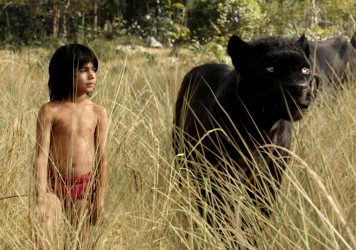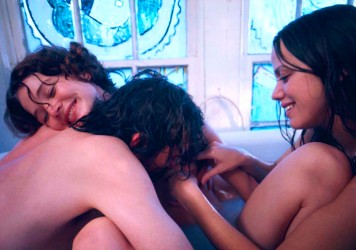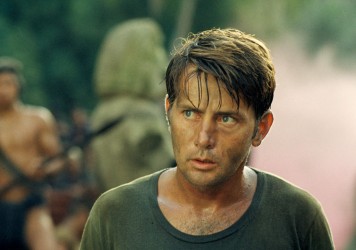
Jon Favreau’s glossy new adaptation of ‘The Jungle Book’ has picked up PETA’s Innovation in Film accolade for its use of “cruelty-free CGI” to recreate the film’s animal ensemble. Does this award point to a wider problem of animal harm within the film industry? In the UK the BBFC take a rigorous stance on animal welfare but there was a time, not so long ago, when CGI wasn’t available to prevent a variety of critters from getting the chop.
Violence towards animals in film dates as far back as Thomas Edison’s 1903 silent short, Electrocuting an Elephant. As the title soberly implies, the 90-second film shows the fatal electrocution of Topsy the elephant in Luna Park, Coney Island. Edison initially planned to hang the animal (seriously) before the American Society for the Prevention of Cruelty to Animals intervened. An estimated 1,500 people witnessed the event, and Edison Studios made it available for a wider audience’s viewing pleasure via their coin operated kinetoscopes.
In John Alberti’s book, ‘Screen Ages: A Survey of American Cinema’, he describes Edison Studio’s early output as a series of “actualities” – moving images documenting a real life event, such as the aftermath of the 1906 earthquake that rocked San Francisco. Contextualising Edison’s early works as historical document, Electrocuting an Elephant faces the same ethical quandaries that the modern day documentarian has to confront; determining the line between filming violence and intervening to prevent it.
Andrey Tarkovsky’s 1966 movie Andrei Rublev, which charts the tumultuous historical period of 15th century Russia, stirred up controversy through the killing of a horse. The dramatic execution depicts a horse falling down a flight of stairs, frantic and unable to regain its balance from the fall. Soldiers then descend upon it and spear it to death. The horse’s fate was already sealed, however, as it was sourced from a slaughterhouse for the production and was due to be shot the following day. Despite its contentious nature, the film is widely praised for its ingenuity. Steve Rose in The Guardian heralded it as the “best art-house film of all time,” while the BFI placed it at number 27 on their ‘Critics’ Top 100’ poll, inviting the age-old discussion of whether art can ever justify violence.
Condemned for its uncompromising insight into the illicit world of cockfighting – where roosters are bred to fight each other to line the pockets of sleazy gamblers – Monte Hellman’s film kicked up quite a fuss upon its release in 1974. Sourcing actual footage of the bloody sport, the film remains banned in the UK, infringing on the BBFC’s Cinematograph Film (Animals) Act 1937 guidelines, which explicitly state: “It is illegal to show any scene ‘organised or directed’ for purposes of the film that involves actual cruelty to animals.” However, with the advent of the internet and all the infinite possibilities that it yields, it’s now possible to get your grubby paws on an import. But you didn’t hear it from us.
Francis Ford Coppola’s seminal war epic sees a water buffalo ritually slaughtered by the indigenous Montagnard people. The killing is intercut with a comparatively tame sequence of Colonel Kurtz (Marlon Brando) being attacked by a machete wielding Martin Sheen. The BBFC still gave it the green light for a UK release, however, asserting that since the sacrifice was part of a cultural tradition, it did not violate any acts that prohibit animal cruelty.
Coppola reiterates this point in the DVD commentary, suggesting that he was merely filming what he saw. However, a 2003 article on the making of the film, for which local extras and crew were interviewed, claimed that Coppola actually provided the animal and reconstructed the ritual after observing one previously. With the endless tales of chaos and delirium that beset the production of the film, it’s hardly a farfetched notion.
Following a documentary crew as they venture into the Amazon to film local cannibal tribes (big mistake), the ensuing episodes of graphic violence inflicted on fellow humans and animals caused Ruggero Deodato’s 1980 exploitation flick to become mired in controversy. Although there are several counts of animal cruelty throughout, one notorious scene stands out – the disembowelling and cooking of a yellow-spotted river turtle.
The backlash to this film was so rife that its gritty realism led to snuff piece allegations being brought against Deodato in court (he was later cleared) and he also incurred a fine for the animal cruelty. If you’re in the market for savagery in sharp definition but aren’t overly keen on seeing Donatello get diced, the director’s Blu-ray edit comes with the option to experience the film’s violent onslaught with less creature culling.
Park Chan-wook’s ruthless revenge flick is testament to South Korea’s reputation for sadistic inventiveness. Choi Min-sik took method acting to nauseating new heights for his turn as the film’s sociopathic anti-hero, Oh Dae-su, by eating a live octopus, tentacles and all. At the time, The Guardian’s Peter Bradshaw speculated the scene “must have given the BBFC censors some sleepless nights.” Four live octopuses were consumed in the making of this scene. Although octopus is considered a commonplace delicacy in South Korea, Choi Min-sik is a Buddhist and prayed after eating each one.
Playing out as a romantic coming-of-age drama, audiences at the 2014 Cannes Film Festival were understandably caught off guard when director Naomi Kawase subjected them to the slaughter of not one but two goats. Set on the soothing subtropical Japanese island of Amami, the scene seems a tad out of step with the film’s otherwise placid tone. Although the close up shot of the goat’s throat being sliced was cut from the UK release, the gruesome scene was retained in other, apparently less pro-animal territories.
Published 12 Apr 2016

Jon Favreau brings Rudyard Kipling’s classic tale crashing into the 21st century. The result is astonishing.

A previously lost film provides a fascinating insight into the actor’s unorthodox creative process.

A jaw-dropping spectacle and brain-melting existential nightmare, Francis Ford Coppola’s Vietnam opus is touched by genius.